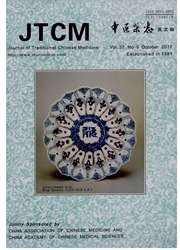

 中文摘要:
中文摘要:
目的将在主要痛经的针灸治疗期间在 acupoints 观察毛状的血流动并且获得新卓见进它的止痛机制。有主要痛经的方法病人被注册并且随机分到治疗或控制组。题目的症状被区分进各种各样的繁体中文药(TCM ) 症候群并且与刺穿针灸或自我压的右边的 Hegu (LI 4 ) 为 10 对待会议,增加基于症候群的另外的 acupoints。激光点缀被用来在 Hegu (LI 4 ) 在 capillaries 的血管舒缩的振幅和灌注比较变化在前并且在治疗期间。每个题目被要求在治疗前后完成经期疼痛症状观察形式,口头的评价规模,数字评价规模,疼痛等级索引,脸等级规模, Zung 自我等级消沉规模, Zung 自我等级焦虑规模,和数字评价规模。在 10 个会议,症状分数,疼痛索引(PI ) ,和视觉模拟规模(管) 以后的结果在治疗组显著地减少了。在 Hegu (LI 4 ) 的血流动的体积稍微衰退了。没有重要证据支持了那刺破引起的毛状的收缩,但是在 Hegu (LI 4 ) 的毛状的血管舒缩的振幅显著地增加了。结论针灸能增加毛状的血流动,因此以 TCM 理论支持 Qi 和血的流动,它便于疼痛地势。
 英文摘要:
英文摘要:
OBJECTIVE; To observe capillary blood flow at acu- points during acupuncture treatment of primary dysmenorrhea and gain new insights into its anal- gesic mechanism. METHODS: Patients with primary dysmenorrhea were enrolled and randomly assigned to a treat- ment or control group. Subjects' symptoms were differentiated into various Traditional Chinese Medi- cine (TCM) syndromes and treated for 10 sessions with puncturing acupuncture or self-pressing right-hand Hegu (LI 4), adding other acupoints based on syndrome. Laser speckle was used tocompare the change in the vasomotor amplitude and perfusion of the capillaries in Hegu (LI 4) be- fore and during the treatment. Each subject was re- quired to finish the period pain symptoms observa- tion form, verbal rating scales, numerical rating scale, pain rating index, face rating scale, Zung self-rating depression scale, Zung self-rating anxi- ety scale, and numerical rating scale before and af- ter treatments. RESULTS: After 10 sessions, the symptom scores, pain index (PI), and visual analog scale (VAS) de- creased significantly in treatment group. The vol- ume of blood flow in Hegu (LI 4) declined slightly. No significant evidence supported that needling caused capillary contraction, but the capillary vaso- motor amplitude at Hegu (LI 4) increased remark- ably. CONCLUSION: Acupuncture can increase the capil- lary blood flow, thus promoting the flow of Qi and blood in terms of TCM theory, which facilitates pain relief.
 同期刊论文项目
同期刊论文项目
 同项目期刊论文
同项目期刊论文
 Observation ofMicrovascular Perfusion in the Hegu (LI4) Acupoint Area after Deqi Acupuncture at Quch
Observation ofMicrovascular Perfusion in the Hegu (LI4) Acupoint Area after Deqi Acupuncture at Quch 期刊信息
期刊信息
